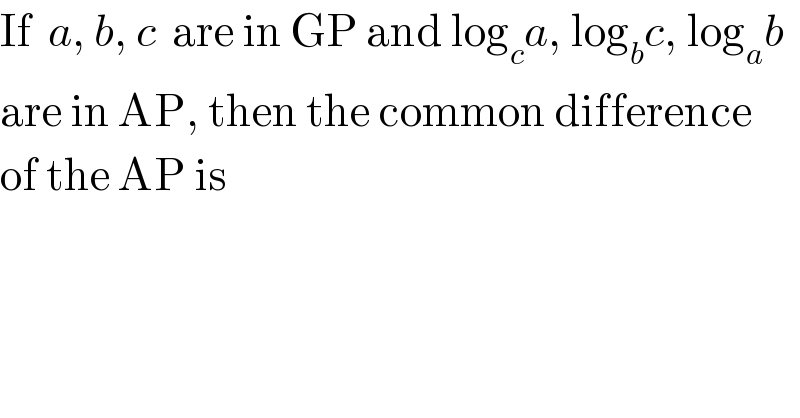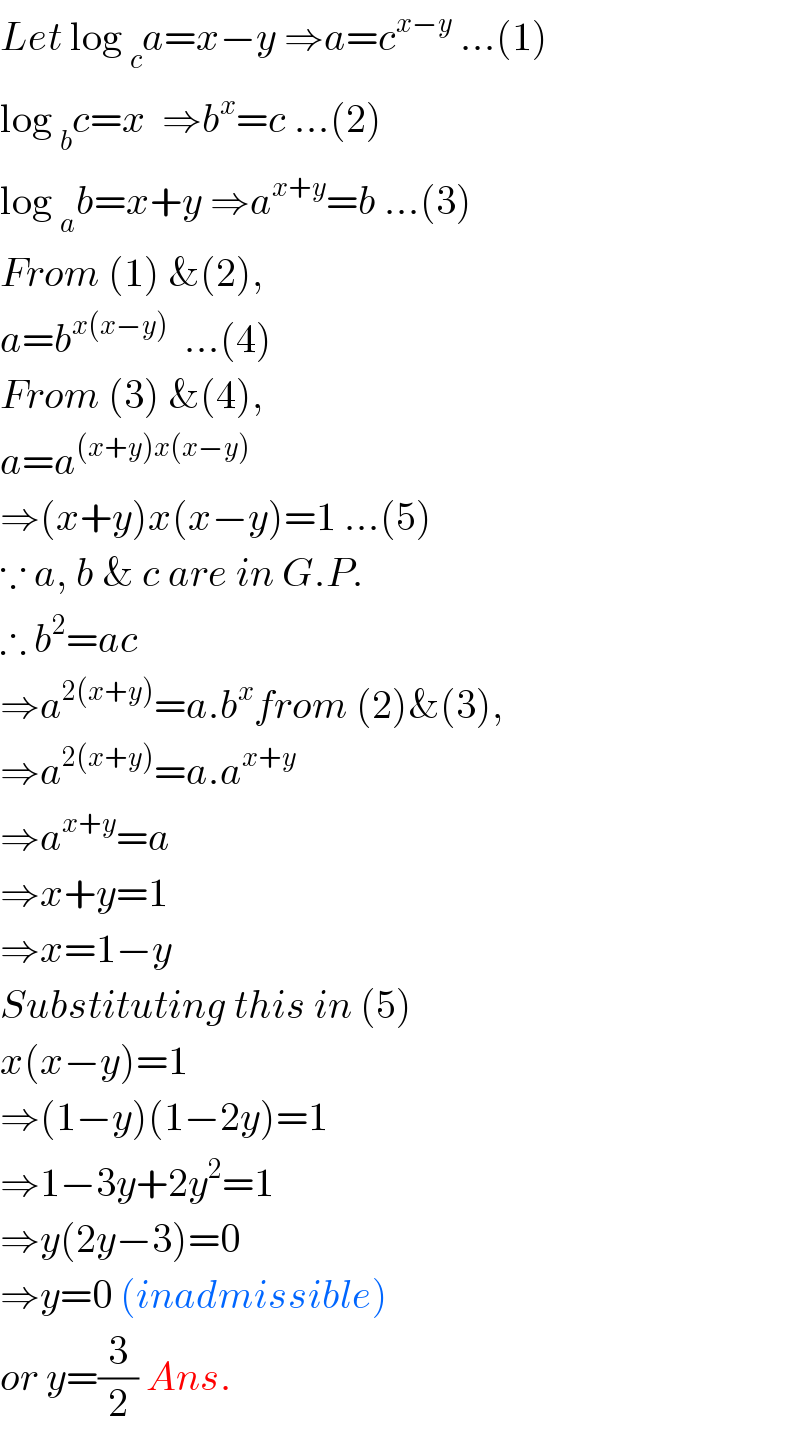Question Number 43602 by peter frank last updated on 12/Sep/18

$$\mathrm{If}\:\:{a},\:{b},\:{c}\:\:\mathrm{are}\:\mathrm{in}\:\mathrm{GP}\:\mathrm{and}\:\mathrm{log}_{{c}} {a},\:\mathrm{log}_{{b}} {c},\:\mathrm{log}_{{a}} {b} \\ $$$$\mathrm{are}\:\mathrm{in}\:\mathrm{AP},\:\mathrm{then}\:\mathrm{the}\:\mathrm{common}\:\mathrm{difference} \\ $$$$\mathrm{of}\:\mathrm{the}\:\mathrm{AP}\:\mathrm{is} \\ $$
Answered by $@ty@m last updated on 12/Sep/18

$${Let}\:\mathrm{log}\:_{{c}} {a}={x}−{y}\:\Rightarrow{a}={c}^{{x}−{y}} \:…\left(\mathrm{1}\right) \\ $$$$\mathrm{log}\:_{{b}} {c}={x}\:\:\Rightarrow{b}^{{x}} ={c}\:…\left(\mathrm{2}\right) \\ $$$$\mathrm{log}\:_{{a}} {b}={x}+{y}\:\Rightarrow{a}^{{x}+{y}} ={b}\:…\left(\mathrm{3}\right) \\ $$$${From}\:\left(\mathrm{1}\right)\:\&\left(\mathrm{2}\right), \\ $$$${a}={b}^{{x}\left({x}−{y}\right)} \:\:…\left(\mathrm{4}\right) \\ $$$${From}\:\left(\mathrm{3}\right)\:\&\left(\mathrm{4}\right), \\ $$$${a}={a}^{\left({x}+{y}\right){x}\left({x}−{y}\right)} \\ $$$$\Rightarrow\left({x}+{y}\right){x}\left({x}−{y}\right)=\mathrm{1}\:…\left(\mathrm{5}\right) \\ $$$$\because\:{a},\:{b}\:\&\:{c}\:{are}\:{in}\:{G}.{P}. \\ $$$$\therefore\:{b}^{\mathrm{2}} ={ac} \\ $$$$\Rightarrow{a}^{\mathrm{2}\left({x}+{y}\right)} ={a}.{b}^{{x}} {from}\:\left(\mathrm{2}\right)\&\left(\mathrm{3}\right), \\ $$$$\Rightarrow{a}^{\mathrm{2}\left({x}+{y}\right)} ={a}.{a}^{{x}+{y}} \\ $$$$\Rightarrow{a}^{{x}+{y}} ={a} \\ $$$$\Rightarrow{x}+{y}=\mathrm{1} \\ $$$$\Rightarrow{x}=\mathrm{1}−{y} \\ $$$${Substituting}\:{this}\:{in}\:\left(\mathrm{5}\right) \\ $$$${x}\left({x}−{y}\right)=\mathrm{1} \\ $$$$\Rightarrow\left(\mathrm{1}−{y}\right)\left(\mathrm{1}−\mathrm{2}{y}\right)=\mathrm{1} \\ $$$$\Rightarrow\mathrm{1}−\mathrm{3}{y}+\mathrm{2}{y}^{\mathrm{2}} =\mathrm{1} \\ $$$$\Rightarrow{y}\left(\mathrm{2}{y}−\mathrm{3}\right)=\mathrm{0} \\ $$$$\Rightarrow{y}=\mathrm{0}\:\left({inadmissible}\right) \\ $$$${or}\:{y}=\frac{\mathrm{3}}{\mathrm{2}}\:{Ans}. \\ $$
